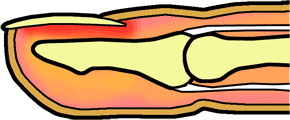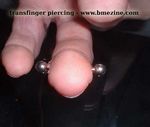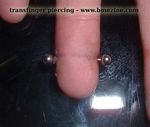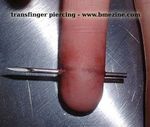Transfinger Piercing
In many ways, the pad of a finger is similar to an earlobe — essentially just skin covering some fatty filler tissue. In most of the finger this is complicated by nerves and tendons, but in the final joint, not only is the bone recessed and thinner, but the tendons and other essential "don't mess around near me" anatomy is not as present, making a transfinger piercing more plausible. A deep placement in this area can allow for a piercing of the hand that is far less prone to rejection than other finger, webbing, and surface piercings.
Not enough examples of this piercing have been done to say exactly what its healing times and success rates are, but anyone trying it should be aware that by definition this location is going to come in contact with much more foreign bacteria and contaminants and irritants in general than a normal piercing. This can of course complicate and slow the healing.
The example above, by Matt Bruce in Victoria BC, was pierced without complication and appeared to be healing well over the first month in which it was monitored.



